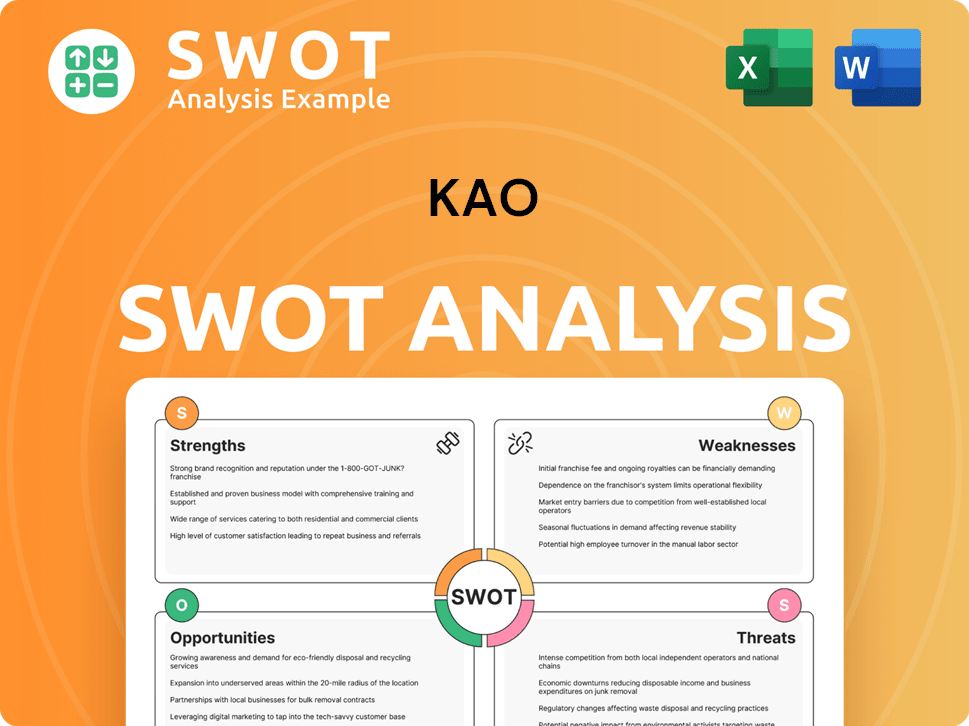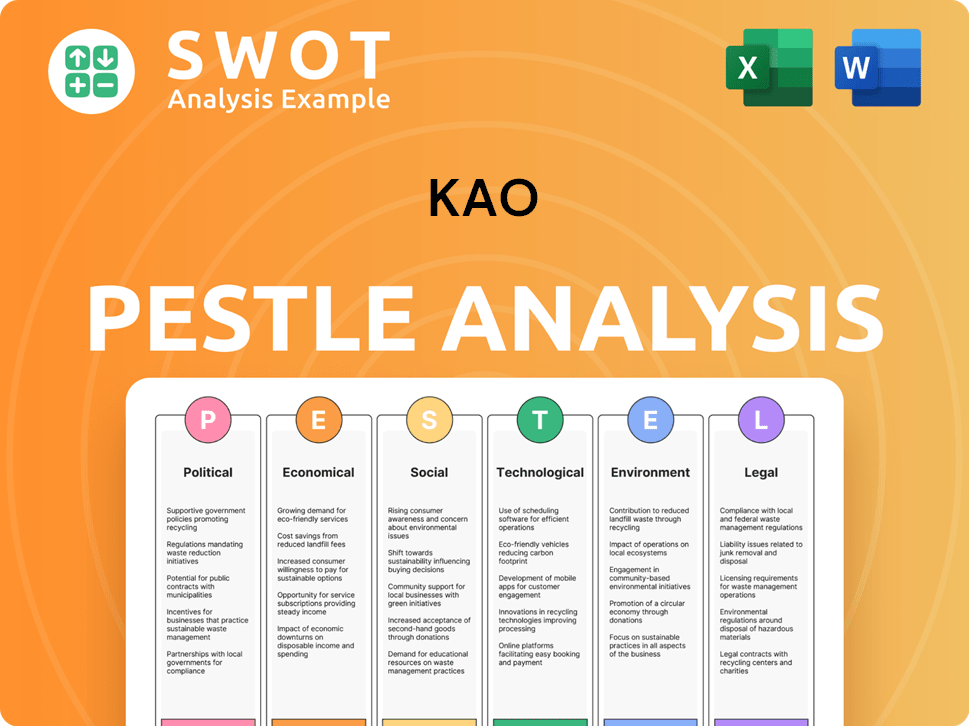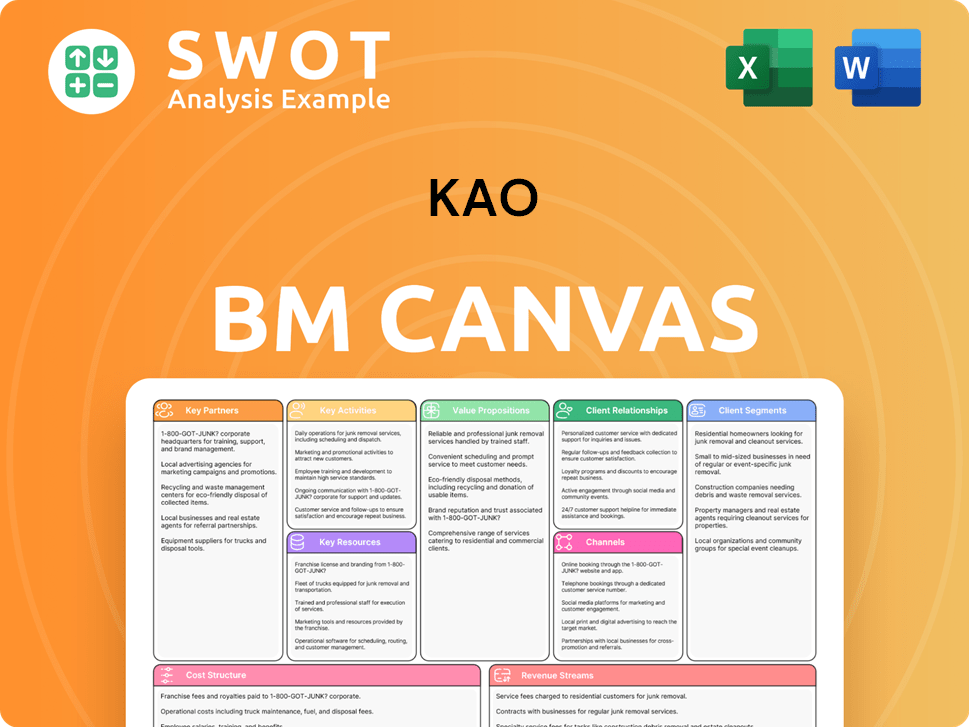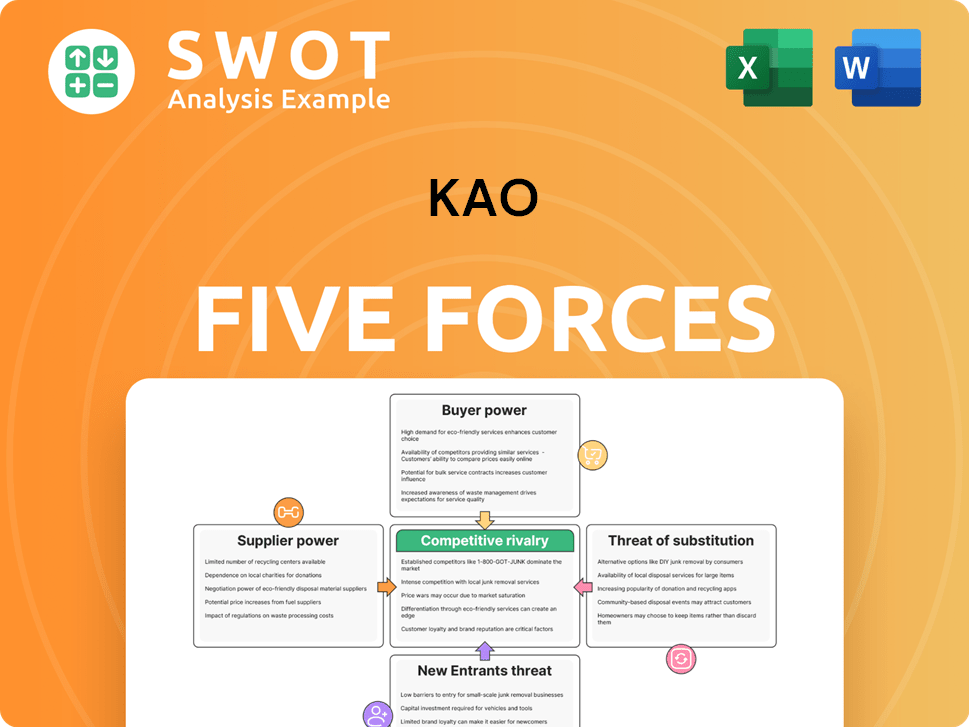Kao Bundle
Decoding Kao: Who Are They Really Selling To?
Kao Corporation, a global powerhouse in beauty, health, and home care, thrives on understanding its customer base. From its humble beginnings as a soap maker, Kao has evolved, strategically targeting specific demographics and market segments. A deep dive into Kao SWOT Analysis reveals the company's keen awareness of consumer preferences and market dynamics.

Understanding the Kao Company target market and Kao Corporation demographics is crucial for investors and strategists alike. This analysis explores Kao's target consumer profile, examines Kao Company market research methodologies, and uncovers Kao Company customer segmentation strategies. By examining Kao Company consumer behavior and Kao Company customer buying patterns, we gain insights into how Kao adapts its offerings to meet evolving consumer needs, including Kao Company customer age range and Kao's demographic breakdown.
Who Are Kao’s Main Customers?
Understanding the Customer demographics and target market of the company reveals its strategic approach to product development and market penetration. The company's diverse portfolio, spanning beauty care, health care, fabric care, and chemicals, allows it to serve a wide array of consumers and businesses. This analysis explores the key customer segments that the company focuses on, providing insights into its market segmentation strategies and consumer profile.
The company's consumer products business targets a broad demographic, including women of various age groups for its skincare and makeup lines. The company also adapts to demographic shifts, such as the rise of Gen Z men, by launching brands like UNLICS, which offers cosmetics specifically designed for younger male consumers. Furthermore, the company's hygiene and living care products cater to households and individuals seeking effective and convenient solutions for daily living, highlighting a focus on meeting diverse consumer needs.
The company's B2B presence through its Chemical segment provides oleochemicals, functional materials, and specialty chemicals to various industries. The company's 'Global Sharp Top Strategy' aims to drive global expansion and increase sales outside Japan to JPY 800 billion by FY27F, indicating a strategic move to grow its international consumer base, particularly in high-growth segments like skincare and cosmetics. This expansion is supported by the recovery in its cosmetics segment in China, demonstrating the company's ability to adapt to changing market dynamics.
The company's beauty and personal care segment focuses on women of various age groups, particularly for skincare and makeup products. The KATE brand, a leading makeup brand in Japan, is expanding its presence across Asia. The company is also targeting younger male consumers (Gen Z) with brands like UNLICS, offering cosmetics specifically designed for them. The company aims for JPY 200 billion (USD 1.38 billion) in hair care sales by 2027, indicating a focus on premium offerings.
The hygiene and living care segment caters to households and individuals. Products include fabric care, home care, and sanitary items. This segment focuses on providing effective and convenient solutions for daily living. The company's offerings are designed to meet the needs of a broad consumer base seeking practical and accessible products for their homes.
The chemical segment serves businesses across various industries. It provides oleochemicals, functional materials, and specialty chemicals. Specific demographic data for these B2B customers is not publicly detailed, but they are typically businesses that use these chemical products as raw materials or components. This segment supports the company's diverse revenue streams and market presence.
The company's 'Global Sharp Top Strategy' aims to increase sales outside Japan to JPY 800 billion by FY27F. This strategic move focuses on growing its international consumer base, particularly in high-growth segments like skincare and cosmetics. The recovery in its cosmetics segment in China highlights its ability to adapt to changing market dynamics and capitalize on emerging opportunities.
The company's target market is segmented across consumer and B2B sectors, with a strong emphasis on global expansion and adapting to evolving consumer preferences. The company’s focus on innovation and premium offerings, such as its hair care products, reflects a strategy to capture higher-value segments. The company's ability to identify its target market is evident in its product launches and expansion strategies.
- Consumer Profile: Women of various age groups, Gen Z men, and households seeking effective and convenient solutions.
- Market Segmentation: Beauty care, health care, fabric care, and chemicals.
- Geographic Target Markets: Expanding internationally, with a focus on Asia and high-growth markets like China.
- Customer Buying Patterns: Willingness to invest in premium products, as seen in the hair care segment.
Kao SWOT Analysis
- Complete SWOT Breakdown
- Fully Customizable
- Editable in Excel & Word
- Professional Formatting
- Investor-Ready Format

What Do Kao’s Customers Want?
Understanding the customer needs and preferences is crucial for the success of any company, and the same applies to Kao. The company's customers are driven by a diverse range of needs, from practical efficacy to aspirational beauty, and a growing demand for sustainable and personalized solutions. This focus allows Kao to tailor its product offerings and marketing strategies to meet the evolving demands of its diverse customer base.
In the beauty care segment, consumers are increasingly prioritizing products that offer unique technologies and performance, with a growing emphasis on offerings that integrate ESG (Environmental, Social, and Governance) perspectives. This shift is evident in the Japanese cosmetics market, where Kao is a key player, seeing increased demand for premium hair care products and organic and natural cosmetics, particularly among millennials and Gen Z.
Purchasing behaviors are influenced by a desire for convenience and specialized solutions. Kao addresses these preferences through innovative offerings like the ribonucleic acid (RNA) analysis subscription model service for its Curél and Sofina brands, launching in 2025. This service provides personalized skincare based on individual biological data, directly responding to the unmet need for highly customized skincare.
Consumers in the beauty care segment seek products with unique technologies and proven performance. This includes a focus on premium hair care and skincare solutions. Kao's innovations in this area directly address these needs.
There is a growing demand for products that align with environmental, social, and governance (ESG) principles. This is particularly evident among younger consumers who prioritize ethical and sustainable practices. Kao is adapting to these trends.
Customers are looking for personalized solutions that cater to their individual needs. Kao's RNA analysis subscription model service exemplifies this trend. This is a direct response to the demand for tailored skincare.
Consumers value convenience and seek specialized solutions that address specific pain points. Kao's development of humidity-responsive UV sunscreen technology is a response to this need. This is a key factor in customer purchasing behavior.
Loyalty is influenced by trust in brand reputation, product performance, and alignment with ethical practices. Kao's diverse customer base values these factors. Kao's marketing strategies focus on building and maintaining this trust.
Digital natives prefer personalized experiences, and Kao is investing in digital marketing to reach them. This includes social media and influencer campaigns. Kao understands the importance of digital engagement.
To effectively meet customer needs, Kao employs several strategies. These strategies are designed to ensure the company remains competitive and relevant in a rapidly changing market.
- Product Innovation: Kao continually develops new products that address specific customer pain points. For example, the humidity-responsive UV sunscreen technology for the Bioré UV lineup.
- Personalized Services: The introduction of the RNA analysis subscription model service for the Curél and Sofina brands in 2025, offering personalized luxury solutions and beauty counseling.
- Digital Marketing: Investment in digital marketing capabilities, including social media and influencer campaigns, to reach digital natives who prefer personalized experiences.
- Localization: Localizing packaging copy and managing owned channels and social media to resonate with diverse audiences.
- B2B Solutions: For its B2B customers in the chemical segment, Kao focuses on providing high-performance, reliable, and energy-efficient solutions, with a strong emphasis on sustainability.
Kao PESTLE Analysis
- Covers All 6 PESTLE Categories
- No Research Needed – Save Hours of Work
- Built by Experts, Trusted by Consultants
- Instant Download, Ready to Use
- 100% Editable, Fully Customizable

Where does Kao operate?
The geographical market presence of the company is extensive, spanning across Asia, Europe, and the Americas. With a strong foothold in Japan, which is its largest market, the company is strategically expanding its reach in other regions. This global approach is designed to cater to diverse customer demographics and preferences, ensuring product market fit across various consumer profiles.
Japan accounts for approximately 50% of sales and operating profits, highlighting its significance. The company is actively strengthening its market position in Asia, excluding Japan, where it contributes around 15% of group sales. Initiatives like launching new products and investing in regional infrastructure demonstrate its commitment to these markets.
In the Americas, the company's presence contributes about 13% of FY24 net sales, and Europe accounts for roughly 11%. The company is accelerating its skincare growth with the launch of its Curél brand in Germany and France, indicating a strategic expansion in European markets. Understanding the company's customer demographics and target market is crucial for its continued success.
Japan remains the primary market, contributing significantly to revenue. The company continues to innovate and maintain its strong presence in its home country. The company's success is partly attributed to its deep understanding of the local consumer behavior and preferences.
Asia, excluding Japan, is a key growth area for the company, with a focus on countries like China, Indonesia, and Thailand. The company is investing in infrastructure and launching new products to strengthen its market position in these regions. This expansion is part of the company's strategic plan to diversify its revenue streams.
The Americas and Europe represent important markets for the company's global strategy. The company is working to increase its market share through strategic product launches and expansions. The company's focus on skincare in Europe shows its commitment to meeting consumer preferences.
The company tailors its offerings and marketing strategies to suit local preferences and needs. This includes adapting products, conducting market research, and partnering with local distributors. The company's approach ensures relevance and resonance with its target audience.
To succeed in diverse markets, the company localizes its offerings and marketing strategies. This includes adapting products and marketing to local preferences, conducting thorough market research, and partnering with local distributors and retailers. For instance, the company Vietnam has enhanced its sales and customer loyalty through a tailored O2O CRM system and mobile app integration, specifically addressing the local market's needs in the Beauty Advisor channel. The company also engages in strategic collaborations, such as the one with Charoen Pokphand Group in Thailand, to co-create sustainable consumer and chemical products and leverage CP's extensive retail and distribution network, including 7-Eleven convenience stores. The company's Mid-term Plan 2027 ('K27') includes a 'Global Sharp Top Strategy' aimed at increasing sales outside Japan to JPY 800 billion by FY27F, reflecting a clear focus on strengthening its global presence and market share beyond its domestic stronghold. Understanding Revenue Streams & Business Model of Kao is key to grasping the company's financial strategies.
Kao Business Model Canvas
- Complete 9-Block Business Model Canvas
- Effortlessly Communicate Your Business Strategy
- Investor-Ready BMC Format
- 100% Editable and Customizable
- Clear and Structured Layout

How Does Kao Win & Keep Customers?
The Kao Corporation employs a multifaceted approach to customer acquisition and retention, integrating traditional and digital marketing channels. A key focus is on digital transformation to enhance marketing capabilities and customer engagement. This includes leveraging digital platforms, influencer marketing, and strategic partnerships to reach and engage with its target audience.
For customer retention, loyalty programs and personalized experiences are crucial. Kao tailors marketing, product features, and customer experiences to specific segments, adapting strategies based on local preferences and market research. This customer-centric approach, rooted in the 'Yoki-Monozukuri' philosophy, emphasizes continuous improvement and new product development based on customer feedback.
In the first quarter of 2025, Kao proactively invested in marketing, contributing to its strong financial performance. The company continues to refine its strategies, focusing on enhancing brand loyalty through quality product development, accelerated new product launches, and global expansion of high-value-added products.
Kao's digital marketing strategy includes social media marketing, content marketing, and search engine optimization (SEO). The My Kao digital platform had 10 million visitors in 2023, providing direct consumer engagement and a platform for product testing. This digital focus helps Kao understand its Growth Strategy of Kao.
Influencer marketing is a significant part of Kao's customer acquisition strategy. The Bioré UV campaign, in partnership with K-pop group Stray Kids, launched in April 2025 across over 15 countries. This strategy aims to boost brand awareness and provide sun care education to its target market.
Kao Vietnam developed a comprehensive loyalty program that offers exclusive deals and personalized experiences across its product lines, including Merries and cosmetic products. A user-friendly mobile app supports the program, providing features like secure data management and reward tracking.
Kao enhances customer experiences by using customer data and CRM systems. The O2O CRM system in Vietnam centralizes customer data and tracks purchases, enabling personalized interactions. This empowers the sales team with tools for effective sales strategies and superior customer service.
Kao tailors its marketing and product features to specific segments based on thorough market research. This includes adapting products and marketing strategies to local preferences. The 'Yoki-Monozukuri' philosophy drives continuous improvement and new product development based on customer feedback. Kao's focus on understanding customer demographics and consumer behavior is key.
- Adapting products to local preferences.
- Continuous improvement based on customer feedback.
- Focus on consumer preferences.
Kao Porter's Five Forces Analysis
- Covers All 5 Competitive Forces in Detail
- Structured for Consultants, Students, and Founders
- 100% Editable in Microsoft Word & Excel
- Instant Digital Download – Use Immediately
- Compatible with Mac & PC – Fully Unlocked

Related Blogs
Disclaimer
All information, articles, and product details provided on this website are for general informational and educational purposes only. We do not claim any ownership over, nor do we intend to infringe upon, any trademarks, copyrights, logos, brand names, or other intellectual property mentioned or depicted on this site. Such intellectual property remains the property of its respective owners, and any references here are made solely for identification or informational purposes, without implying any affiliation, endorsement, or partnership.
We make no representations or warranties, express or implied, regarding the accuracy, completeness, or suitability of any content or products presented. Nothing on this website should be construed as legal, tax, investment, financial, medical, or other professional advice. In addition, no part of this site—including articles or product references—constitutes a solicitation, recommendation, endorsement, advertisement, or offer to buy or sell any securities, franchises, or other financial instruments, particularly in jurisdictions where such activity would be unlawful.
All content is of a general nature and may not address the specific circumstances of any individual or entity. It is not a substitute for professional advice or services. Any actions you take based on the information provided here are strictly at your own risk. You accept full responsibility for any decisions or outcomes arising from your use of this website and agree to release us from any liability in connection with your use of, or reliance upon, the content or products found herein.